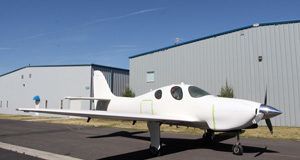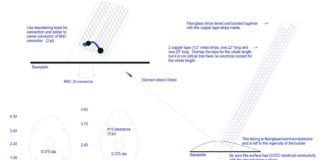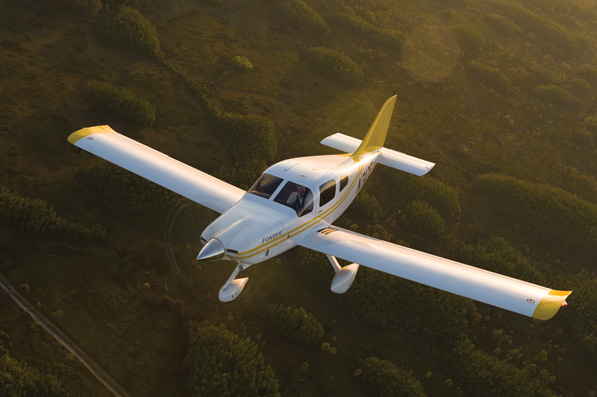
While the piston-powered, four-place market was once a hotbed of activity, it’s much cooler now, particularly at the more affordable end. Back when this magazine was born 25 years ago, the four-seat market was warming up rapidly even as the two-place contingent was clearly in charge. Today, we count only 17 “real” kits for four-place airplanes where the airframe kit itself is less than $50,000. They range from high-wing utility aircraft like the Bearhawk and Dream Tundra to sleek composites like the Jabiru J400 and Velocity, whose fixed-gear models come in under the wire. Van’s RV-10 is, of course, the overdog, based on the quality of the kit, reputation of the company and performance. The Team Tango Foxtrot 4 fits into the affordable category perfectly—it’s a full-size four-place airplane whose airframe kit sells for $45,995.
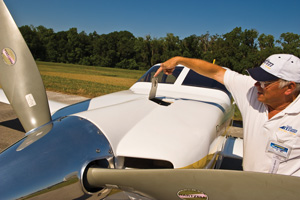
Typical oil-door access limits preflight inspection possibilities. Note the spinner extension fairing as part of the top cowling, which helps place the narrow air inlets low enough to improve pilot sightlines.
At Sun ’n Fun this year, I met Pete Mercuro, the Team Tango director of business development, and he invited me to fly to the company’s location at Williston, Florida, (airport identifier X60) for a flight in the Foxtrot 4 demonstrator aircraft with Dennis Funnemark, the director of operations and chief test pilot.
A Bit About the Airplane
The Foxtrot 4 is kind to the eyes, with a sleek side-by-side cockpit configured for four places in a conventional layout. (No one facing backward, for example.) This composite airplane sits on a well-faired fixed tricycle landing gear. The long nose required to hold the 300-horsepower Lycoming IO-540 and Hartzell three-blade propeller seems adequately balanced by a generous vertical tail. You can also save a few bucks and build the Foxtrot with a four-cylinder IO-360.The straight wing, with an 8:1 aspect ratio, provides a reasonable wing loading of 23.4 pounds per square foot at maximum gross weight, and is matched by a straight horizontal tail with conventional elevator and trim surfaces. Fuel is carried in a “wet wing” configuration with a total capacity of 100 gallons with up to 200 gallons as an option.
The Foxtrot 4 we would be flying, N747F, is an earlier version the kit. It is customer built and owned, and made available to Team Tango as a demonstrator. Later and current production kits include some important changes. One significant one was a ream alignment of aileron and flap assemblies, which will be discussed later. From appearances, this could be a fun airplane to fly, and with the ample 300-hp Lycoming, performance could be quite interesting.
Ready to Aviate
Cabin entry requires a long stretch onto the wing, and an entry step would be welcomed by most pilots. The seats are well positioned vertically, with fore and aft adjustment. The sticks and rudder pedals were also well positioned with reasonable motion and no stick/leg interference. Seat position is a customer choice, so the owner and I must be about the same size.
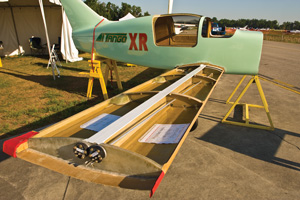
The Foxtrot 4 kit, as displayed at the airshows. Virtually the entire wing can be wet with fuel; standard capacity is 100 gallons total.
Moving the controls indicated light elevator friction (the control system in this axis is through pushrods), normal rudder friction (through typical cables) and rather high aileron friction.
The flight example Foxtrot’s panel layout was set up for the left seat, featuring real gauges—you can tell I’m not a glass guy—with the GPS as the only LCD screen. Engine and pitch trim controls are located on center panel. So far, this Foxtrot is totally conventional. Cockpit visibility is typical for a side-by-side configuration, but it is especially good over the nose.
Starting the big Lycoming required the usual injected-engine maneuvers, and runup was straightforward. Taxi was easily controlled. Prop wash at taxi power settings allowed some steering with rudder only. Tighter turns required differential braking to move the free-castering nosewheel. Again, this Foxtrot 4 could be like any number of homebuilts, and that’s a good thing.
Finally Flying
Funnemark demonstrated the first takeoff, rotating at 70 mph IAS, with liftoff at 75 mph IAS. Ground roll on the paved runway with 10 knots of headwind was about 400 feet. On subsequent takeoffs, I found that directional and pitch control for rotation required only normal techniques.
When initial climb is set to the best airframe climb speed of 90 mph IAS, the rate is better than 2000 fpm, but the deck angle is a little too spectacular for good visibility forward. A cruise climb of 110 to 120 mph IAS, and power setting of 24 inches of manifold pressure and 2550 rpm provide an adequate climb rate of 1200 to 1500 fpm, and good over-the-nose visibility.
Stability checks during the climb showed control harmony to be adequate, with pitch forces lighter than the rather heavy roll forces. The aileron friction I noticed on the ground was not apparent at this speed, probably due to aerodynamic hinge moments providing adequate centering. Good longitudinal (pitch) stability was verified by the presence of a long period mode, moderately low frequency short period mode, and adequate pitch force per G of 3 to 4 pounds. Pitch force velocity gradients (pitch force per speed change) were light but adequate.
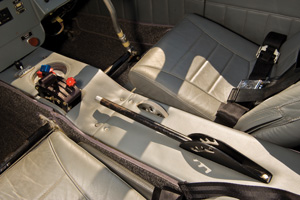
A wide central tunnel holds a manual flap lever, palm-ready trim wheel and quadrant power controls.
Adverse yaw was light, and there was good lateral (roll) stability. Yaw (directional) stability checks displayed a low Dutch roll frequency but with adequate damping. The Dutch roll consisted of equal amounts of roll and yaw; pilots like that.
Doing the Cruise
The Foxtrot showed it was made to cruise fast. Leveling at 8000 feet MSL, we set power at 22 inches of manifold pressure and 2230 rpm—this is approximately 60% to 62% power for the brawny Lycoming, providing an IAS of 168 mph. With the OAT at 15° C, this calculated to 196 mph TAS. A set of GPS ground speed runs revealed almost no wind, and verified a TAS of 195 mph, or 169 knots true. This performance, on approximately 14 gph, will match or exceed that of many four-seat, retractable-gear aircraft, which are (do we have to say it?) considerably more expensive.
OK, so a good aircraft is not just about pure speed. Trimability was good in this flight condition as was visibility, except in the direction of the opposite seat, typical of side-by-side configurations. Pitch force per G was 4 to 6 pounds. The velocity gradient (pitch force per speed change) was light but adequate. There was a low level of adverse yaw and bank angles were easy to attain (roll damping was good) and maintain (spiral stability). As with the climb condition, aerodynamic hinge moments were countering aileron friction. The directional axis was moderately stable as demonstrated by a moderately low Dutch roll frequency with five to six overshoots required to damp sharp yaw inputs.
Regardless of all these technical comments, the Foxtrot 4 has stability and handling qualities well suited to cruise flight tasks. Attitude, heading, altitude and speed control were easy to achieve and maintain. Pilot workload was low in this flight regime.
Next on the list: clean stalls. The 1 G (unaccelerated) stall occurred at 75 mph IAS with a normal nose-down break, requiring only normal stall recovery procedures; however, directional stability was somewhat loose, requiring additional attention to aileron and rudder inputs. Accelerated stalls were not conducted, as spin testing is not complete.
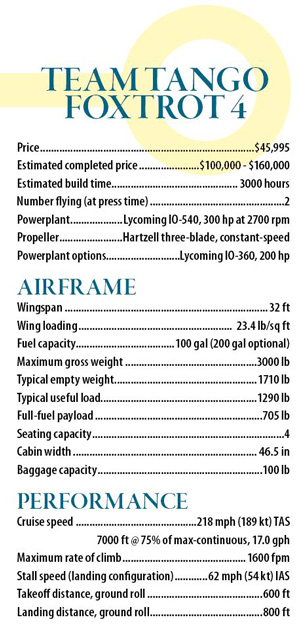
Slow flight was conducted at the same altitude and temperature conditions as cruise. Power was set at 14 inches and 2360 rpm to hold 80 mph IAS in the full flap configuration. The 80-mph IAS required full nose-up trim. Slower speeds required some back pressure, but as the velocity gradients were low, this was not a problem. What really got my attention was the poor pitch/roll harmony. Pitch forces were even lighter at this speed, and roll forces were excessively high, and with the lower aerodynamic hinge moments no longer providing centering, aileron friction was quite apparent. There was positive static and dynamic pitch stability, but pitch force per G was down to 1 to 2 pounds. Those responses are at the very bottom of the acceptability scale, it’s true, but coupled with high roll friction and forces some inadvertent pitch inputs were inevitable. The pilot’s workload is much greater in this flight regime.
The directional axis was stable, but at a reduced level. The Dutch roll was somewhat sluggish with a longer time to damp directional disturbances. Adverse yaw had increased to a level that any mismanagement of pilot compensation would result in excitation of the Dutch roll. This coupled with the high aileron forces made directional control more difficult. A relatively high level of pilot compensation was required to accomplish maneuvering tasks such as turns to a precise heading.
The unaccelerated landing-configuration stall occurred at 65 mph IAS. Normal stall recovery techniques were effective with little loss of altitude. As in the cruise configuration, directional stability was somewhat loose, requiring aileron/rudder coordination with higher than normal force in both axes. The pitch axis was well behaved in the recovery. Accelerated stalls were not conducted in the landing configuration.
RTB
The descent back to X60 was with the power set at 20 inches/2200 rpm, giving a descent speed of 200 mph IAS. Flying qualities were good in this flight phase.
Finally, landings. Slow flight provided a good prediction of how things would go in the landing phase. Funnemark demonstrated the first landing to a full stop. I followed with a touch and go, and a full stop. The pattern was flown slowing to 120 mph IAS downwind, 100 mph IAS abeam with flaps lowered to the first detent (10°) and the rest of the landing checklist completed. By the 90° position to the runway, the IAS was 90 mph, and another notch of flap (20°) was set. Turning on final the IAS was slowed to 80 mph, and the last notch of flap (30°) was selected. Target airspeed on short final was 70 mph IAS, with some power carried to touchdown.
The weather was clear with good visibility below a 2500-foot scattered-to-broken layer. Wind was pretty much down the runway at 10 knots, slightly gusting to 12 to 15 knots. There was light turbulence all around the pattern with some moderate gusts on short final due to trees. All in all, pretty good conditions for evaluating landings—certainly a lot more useful than a glassy day, where handling deficiencies have a place to hide.
The three landings were similar in pilot performance and achievement of desired landing parameters, which were to touch down in the first third of the runway, on centerline, aircraft aligned with the runway and low sink rate at touchdown. Our touchdowns were in the first third of the runway, but none was exactly on centerline, none had the aircraft perfectly aligned with the runway, and no touchdown was smooth enough to elicit glowing comments from passengers. On all three, we were both doing our best to get it right, and all three were safe, but none was as good as my landing in the RV-4 an hour previous under the same wind conditions.
I can’t blame the difference on experience with the two aircraft. In the Foxtrot, the landing tasks were dominated by very high roll forces and friction, combined with light pitch forces. The task was both mentally and physically demanding. An aircraft with so many other outstanding characteristics should be easier to land, and I don’t think it’s far from achieving that goal.
Think About Loading
The loading on this flight was two average size pilots, with 65 gallons of fuel on board and no baggage. As flown, the pitch stability was adequate, but I felt the CG was not far enough forward considering the two empty rear seats. I was concerned about CG positions with one or two passengers in the back and some baggage. Would this good balance go out the door with a full load? Experience says it very likely would.
Funnemark and I discussed this issue, and he said a larger horizontal tail has been designed for the Foxtrot 4. It was being produced, and would be included in future kits. A larger horizontal tail would increase the CG range of the aircraft, and probably increase pitch forces somewhat. I think he’s definitely on the right track.
The company is working to further reduce aileron friction by replacing bushings with bearings, though an interim step is to ream-align the flap and aileron controls to reduce friction. It is fair to say N747F is probably the worst case scenario in that regard.
Also on the table: Increasing the gearing (mechanical advantage) in the aileron control system and decreasing the gearing in the elevator system, according to Funnemark. Both could significantly improve pitch/roll control harmony.
The Foxtrot 4 is a great performer with the potential to be an honest four-place airplane. It certainly has the load-carrying capability as evidenced by takeoff and climb performance. It’s also fast for a fixed-gear, four-place airplane, and at 75% power should achieve close to advertised cruise speeds.
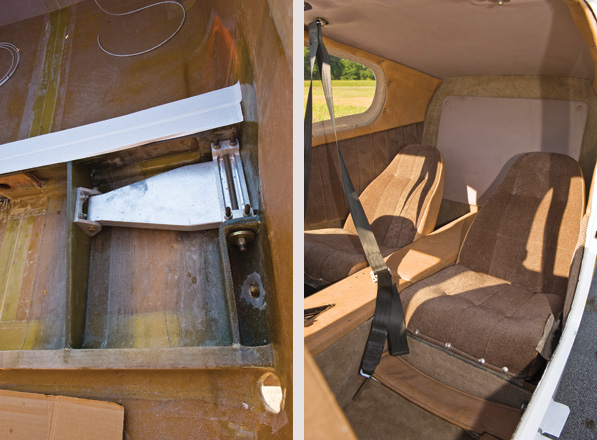
Left: That’s the aft wing spar under the tape, with the inboard ends of the all-metal landing gear poking into the lower cabin structure. This is a naturally strong part of the airplane. Right: A roomy aft cabin holds two full-size, front-facing seats. Central tunnel encloses elevator pushrod and rudder cables; in general, the Foxtrot’s control system is conventional.
Overall, I like this aircraft. The deficient flying qualities I observed are being properly addressed, meaning that customer airplanes should fly better than the example I tried. Besides, if I had one of these I could look pretty sporty, cruise slightly faster than my RV-4, and carry my bicycle as well as my wife…I’ll have to think about that one.
For more information, call 352/528-0982 or visit www.teamtango.com.
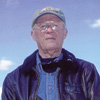
![]()
Chuck Berthe is a retired Naval aviator, civilian test pilot, and aeronautical engineer, with ATP, CIFI, Helo, A&P ratings and two Repairman Certificates. He has logged 1660 pilot hours, and is an Associate Fellow in the Society of Experimental Test Pilots.


